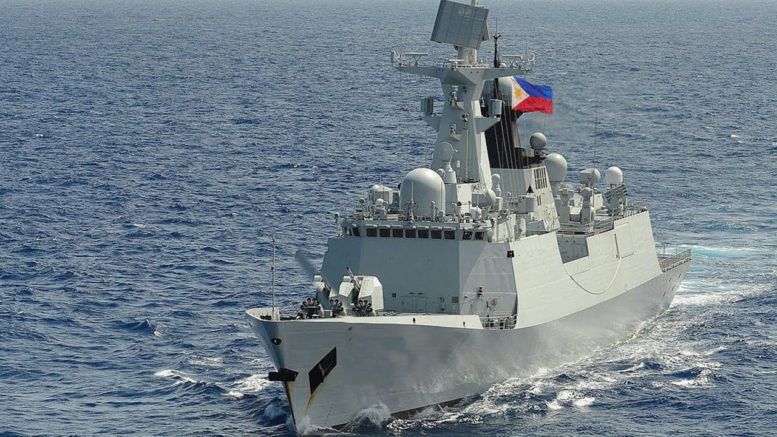INTRODUCTION
The Philippine National Defense Department has signed a contract with Hyundai of South Korea for the construction of two units of the Incheon Class Frigate last 24-October-2016 at the cost of US$337M to modernize the capability of the Philippine Navy’s surface combatants.
This article is a guide to craft the circular of requirements for the Frigate in order to enhance its survivability in combat.
WHY A FRIGATE?
A frigate represents lower investment in terms of cost and displacement compared with a full-size destroyer, making frigates very attractive to many navies. Frigates attain almost the same effective combat capabilities in anti-surface, anti-submarine, and anti-air warfare but with lower operating and maintenance costs.
In terms of displacement, the frigate is between a destroyer and a corvette. Capability-wise, its capability is in this order of priority: (1) anti-air; (2) anti-submarine; and (3) anti-surface.
MODERN WAR AT SEA
Recent conflicts have provided sharp reminders that a surface combatant ship must be able to withstand certain battle damage level, and prevent complete loss of its war-fighting capability. This means survivability.
Enhancing ship survivability has been a focus of several studies on naval warfare. The destructive effects of new weapons launched from the air, surface, and subsurface platforms affected ship designs and ship defense systems. To optimize survivability naval planners must consider some parameters resulting from a number of naval clashes worldwide.
THE FALKLAND WAR OF 1982
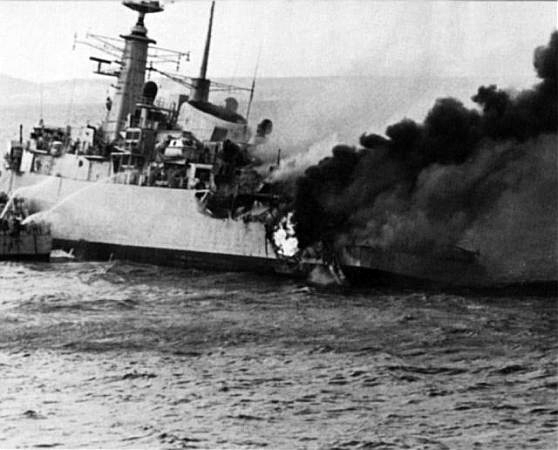
HMS Ardent (F184)
Royal Navy frigate Ardent was attacked by at least three waves of Argentine Ground Fighter Attack Aircraft (GFA). The air strikes caused Ardent to sink. The first attack took place when a lone A-4 Skyhawk dropped two bombs, which straddled the Frigate but failed to explode.
A second coordinated air strike composed of three Skyhawks and IAI Daggers pressed the attack. The only weapons of the Ardent, which reacted to the attack, were 20mm Anti-Aircraft guns. The Sea Dart anti-aircraft missiles system failed to lock-on. The 4.5-inch gun was too slow, ran out of arc of fire, and failed to hit the Skyhawk. Two bombs hit the ship. The auxiliary machinery room and power switchboard were severely damaged, and the helicopter hangar were in flames. The loss of power caused by damaged switchboard rendered the ship’s major combat systems inoperable. Communications were cut off, making the ship defenseless. Thus, the Skipper ordered, “Abandon Ship.”
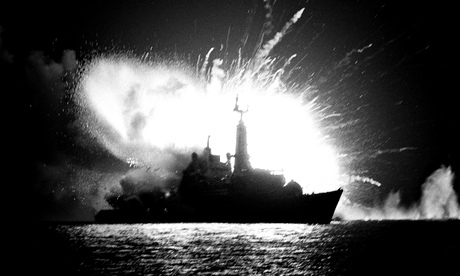
HMS Antelope (F170)
On 23-May-1982, the Antelope came under attack by four A-4 Skyhawks from Grupo 5 of the Argentine Air Force. Antelope was hit by a bomb at the starboard quarter but did not explode. The bomb disposal team made an attempt to defuse the bomb. However, it exploded. The ship was torn open from the waterline, and the blast started major fires in both engine rooms that spread quickly. The starboard fire main was fractured, and the ship lost all electrical power that the Skipper ordered, “Abandon Ship.” Within 5 minutes, after the Commanding Officer was last to abandon ship, the missile magazine room exploded. The explosion fire continued all night.
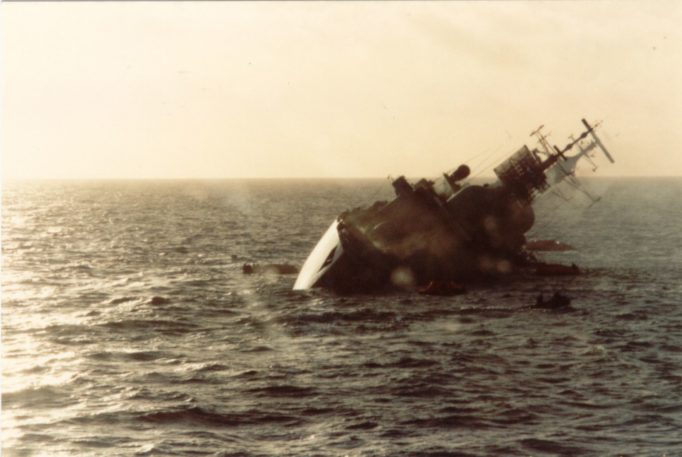
HMS Coventry (D118)
On 25-May-1982, the Argentine Air Force A-4 Skyhawk sunk the Coventry. The ship was fitted with Sea Dart surface-to-air missiles to counter threats from the air. The Sea Dart is constrained by a limitation on its firing capacity and reaction time. Coventry fired a Sea Dart surface-to-air missile but missed the attacking aircraft. Coventry’s targeting radar failed to lock-on, and the tracking system locked down during the attack and could not be reset before the attacking Argentine A-4 Skyhawk released their bombs. However, the attacking A-4 Skyhawk missed the targeted Coventry.
Coventry used the 4.5-inch gun and small arms against the attacking aircraft. The 20mm Oerlikon canon jammed, leaving the ship with only rifles and machine guns to defend itself against the A-4 Skyhawks. The ship greatly suffered from 3 bombs that hit it above the waterline, exploding beneath the computer room, and destroying the Combat Information Center. Coventry then began leaning portside. Within 20 minutes, the Skipper ordered, “Abandon Ship.”
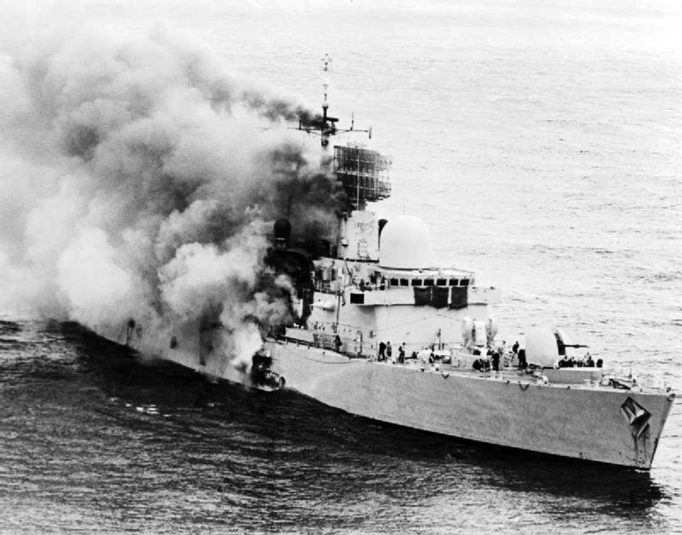
HMS Sheffield (D80)
On 4-May-1982, two Argentine Naval Aviation Units consisting of super Étendard (3-A-2002 and 3-A-2003) fighter aircrafts, both armed with Exocet anti-ship missiles (AM 39) attacked the Sheffield. The Sheffield picked up the signal of the incoming Exocet missile but was late by 5 seconds. The Exocet (AM 39) hit amidship, creating a hole approximately 2.4m above the waterline, tearing a gash in the hull. The damage caused by the missile impact severed the high-pressure fire main pipe. The resulting fire caused by the burning propellant ignited the diesel fuel oil from the ready-use tanks in the engine room. As Sheffield was ablaze, the Skipper ordered, “Abandon Ship.”
THE PERSIAN GULF WAR IN 1987
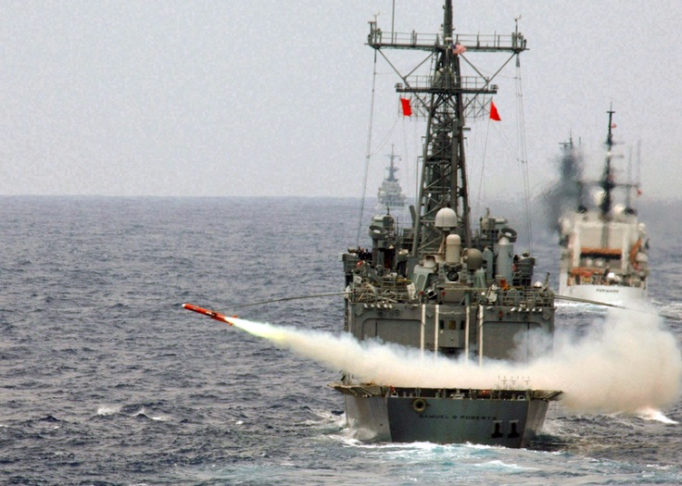
USS Roberts (FFG-58)
On 14-April-1988, the USS Roberts was deployed in the Persian Gulf, and struck an M-08 Naval Mine in the central Persian Gulf. The mine blew a 4.6m-hole diameter in the hull, flooded the engine room, and rendered 2 gas turbines out of operation. The blast broke the keel of the ship. Such structural damage is almost always fatal to most vessels. The ship survived and was brought back to Portland, Maine, USA then carried back by Dutch Shipping with a cost of $1.3M. Repairs and damages reached $89.5M at the shipyard. The ship was decommissioned on 22-May-2015 and has been slated for dismantling.
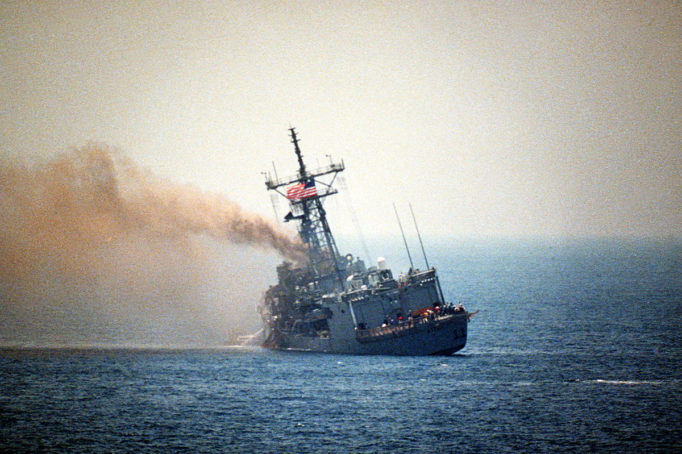
USS Stark (FFG-31)
On 17-May-1987, an Iraqi Mirage F1 aircraft hit the USS Stark with 2 Exocet Anti-Ship missiles. The first missile was fired at stand off range of 22.5 nautical miles (41.7 km) and the second missile at 15.5 nautical miles (28.70 km). The ship’s radar did not detect the missiles. The lookout crew gave the warning only moments before one of the missiles hit USS Stark.
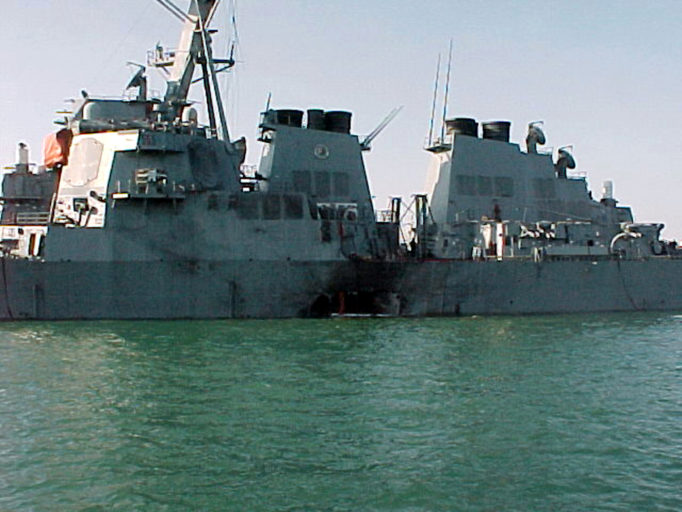
USS Cole (DDG-67)
On 12-October-2000, the USS Cole, while refueling at Yemen’s Aden Harbor, was attacked by Al-Qaeda. A small fiberglass boat loaded with C4 explosives and 2 suicide bombers approached the portside of the destroyer and exploded, creating a 12m x 18m gash on the ship’s portside hull. The blast penetrated the mechanical space, violently pushing the deck up.
Characteristics of Threat. There are various threats to a Frigate. Some of the greatest assortments of weapons platforms that can interfere in the survivability of the Frigates are:
- Ground Fighter Attack Aircraft (GFAA) – capable to launch multiple and coordinated attack at the speed of Mach 2 (ratio of speed of sound versus speed of aircraft), and can launch anti-shipping missiles at a stand off distance of 50 km.
- Attack Helicopter – capable to launch multiple and coordinated attacks with anti-shipping missiles at a stand off distance of 50 km. Helicopters are difficult to destroy, relatively slow, but very agile.
- Shallow Water Attack Submarine – capable to launch wire-guided torpedoes or with homing acoustic guidance system from a distance of 8-10 km, and torpedo speed of 40 knots in extremely shallow waters where it is very difficult to detect and conclude a deliberate attack.
- Fast Attack Missile Boat – a single or multiple attack craft can attack Frigates from different directions, and launch anti-shipping missiles with an active radar-infrared homing system.
- Suicide Terrorist – A Frigate is a sitting duck while docked at the pier. Being stationary and moored alongside the pier makes for an easy target to swimmers and attackers loaded with RPGs.
- Characteristics of Hostile Threat Ordnance – Anti-ship Missiles equipped with active radar homing seeker; infrared homing guidance with a speed of Mach 2; Stand off range of 15km-20km-50km; flight altitude of 20m above water surface; single shot with a kill probability of 90%; Anti-surface Torpedoes capable of 40 knots speed at firing distance of 8-10 km; Guidance system of wire guided or acoustics guided lock-on systems; and Warhead weighing 100 kgs, and capable of splitting the ship’s keel in half. This is the most dreaded ordnance feared by the ship crew.
Naval mines are the weapons that wait at the chokepoint, navigational route of shipping and in extremely shallow water. The charge capacity of mines is 200kg and can destroy surface and submarine targets at a radius of 50 meters. Naval mines can trigger through magnetic and pressure-signature of the target.
SURVIVABILITY OF THE FRIGATE DEFENDS UPON THE FOLLOWING TECHNOLOGY DEVELOPMENT. Survivability is defined as the ability of the Frigate to remain mission capable after multiple combat punishments, and still resume fighting.
- Electronic Warfare Systems – the basic fundamentals of survivability is the effectiveness of the electronic warfare system, superiority, agility and quick response to counter the threat. Defensive measure can be done through the following:
- Reduction of ship signatures – signature control to minimize degree of attraction from hostile anti-shipping missile that could lock-on to radar, and infrared acoustic (torpedoes), magnetic and pressure signatures of the ship that could trigger naval mines underwater to explode.
- Distraction – agility of the Frigate counter-measure electronic warfare equipments to interfere, jam, or distract the guidance system of hostile anti-ship missiles.
- Denial – ability of the Frigate to protect itself by employment of some counter-measures such as:
- Softkill – using chaff, made of aluminum powder spread to the atmosphere, decoys, distraction, and confusion to create a false target and divert the path of the attacking missiles away from the ship.
- Hardkill – using rapid firing guns such as close-in weapons system (phalanx; Goalkeeper) or anti-air-missiles to destroy the attacking anti-ship-missile or aircraft in flight.
- Deception – an electronic warfare role to provide counter-measures to confuse the electronic warfare capability of a hostile threat; or to mislead adversaries with a combination of human mind, mechanical or electronical means to manipulate the decision loop, making it difficult to establish an accurate deliberate decision to attack your ship.
- Disruption and Degradation – to interfere with the hostile forces’ electronic warfare capability through jamming, electronic deception, and electronic intrusion. This acts as a force multiplier by increasing the adversary’s uncertainties to conduct deliberate attacks on your ship.
- Naval Architecture Ship Design. The design of the ship structures, noise emanating from cavitation of the propulsion, inter-action between the hull, and the water called frictional resistance create acoustics are signatures that can be detected by anti-shipping missiles, torpdoes, and naval mines.
- Vulnerability – the capability of the Frigate structure to withstand the spread of damages, and several hits from exploding hostile munitions.
- Recoverability – the ability of the Frigate system and sub-system after temporary stoppage of operation to restore vital ship systems, and resume operation after sustaining combat damage.
- Concentration of vital Equipment – should not be co-located in one place aboard ship to avoid disruption of operations from a single hit.
- Duplications – parallel arrangements of electrical cable installation, firefighting, and damage control equipment must be dispersed to allow use of redundant systems to prevent sudden failure.
- Separations – taking apart similar functions of equipment used in utilities can provide the same functions for another equipment in case of damage in one system.
- Protection – provisions in the ship systems to resist spread of damage during weapon attacks on the Frigate.
- Zoning – vital shipboard services should be grouped to its zone and must have several series of watertight compartments and blast resistance doors.
- Reliability – battle readiness under the system must work accurately and efficiently within a short time scale.
EFFECT OF SUCCESSFUL ATTACK AGAINST A FRIGATE CAN BE BASICALLY DIVIDED INTO THREE (3) PHASES:
- Primary Weapons Effect. This consists of kinetic energy, blast, fragmentation, shockwave, whipping etc. likely from an Anti-Shipping Missile (ASM) hitting the center of the large cross section of the ship. Torpedoes and mines can create underwater explosions lifting the ship from the water, and breaking the ship into parts. Naval Gunfire with armor-piercing shell/high explosive incendiaries could penetrate the hull’s inner section and explode at the interior section of the ship.
- Secondary Weapons Effect. In the aftermath of an attack, a large portion of the lethality is the ability to create a ball of fire from the exploding ordnance and munitions at the magazine room onboard, spreading smoke, confusion, and dead bodies everywhere in the ship.
- Tertiary Weapons Effect. The principal hazard to the ship could be a total loss when the ship becomes dead in the seaway due to power disruption, flooding, inoperable pumps, damage in the engine room, loss of steerage and propulsion, damage in the bridge and combat information center (CIC), collapse of super-structures, before capsizing and sinking to the bottom of the sea. The last ditch defense is damage control, which depends on how fast the damages can be repaired to prevent the ship from sinking to Davy Jones Locker at the bottom of the sea.
Combat Management Systems (CMS) are valuable to match the threat and neutralize the hostile platform and ordnance in flight or underwater. The following are a variety of weapons and sensors managed by the CMS. It must be a proven design with good combat reputation.
Combat Management Systems is the brain of the combat engagement capabilities of the Frigate. The basic principles of the CMS emanate from surveillance, detection, tracking, identification, target acquisition, quick reaction time in acquisition, and neutralization of the target. The CMS provides:
- Situation Awareness – Awareness of sea battle environment, which includes surface, sub-surface, and air. Sensors via radar, electro-optical system and sonar collect the information.
- Intelligence – Convert the information gathered into a timely actionable interpretation, collation, evaluation, and a timely produced common combat operational picture.
- Planning and Decision Making – These steps helps the Frigate commander to rapidly make a quick actionable plan for decision-making and implementation, in a rapidly changing complex battle environment.
- Weapons Systems Command and Control – The CMS will direct weapons, sensors to engage the incoming threat. The CMS is carried out through the crew, sensors and weapons system. It is a software which is flexible to operate in a complex naval battle environment, able to electronically interact with other sub-systems, but interoperable with the system of one’s own as well as other allied navies.
LESSON LEARNED IN THE ABOVE CONFLICTS. Frigate war-fighting doctrine is the primary document in the identification of a threat — how it will be neutralized, and by what weapon. Without a doctrine, a Navy combatant is as good as anyone not knowing how to survive from a hostile threat.
The unimaginable casualties suffered by two powerful navies during naval operations are grim reminders of combat systems management in an actual hostile environment. This involves war-fighting doctrine, systems maintenance, combat systems operators skills, and commander’s decision making. Casualties could be a result of poor CMS systems and sensors maintenance, outdated war-fighting doctrine, and a crew with a lack of combat skills, among others.
The goal of a Navy is to maintain a battle-ready fighting ship. An enormous budget is needed in support of its life cycle cost for the periodic operation and maintenance that a government must set aside. The absence of such plan to maintain a battle-ready warship is a Navy destined to fail and defeated in battle.
Main References:
- OSIRIS Ultra Electronic of England
- A Martins, B Eng (Hons) Rosyth DERA
- BAeSEMA Limited, England
